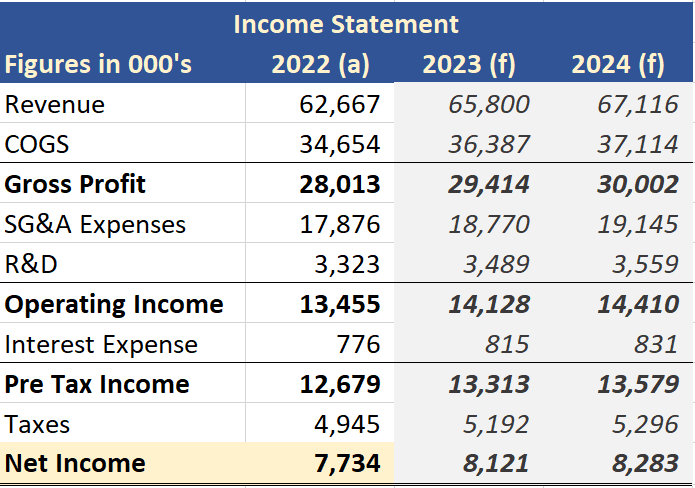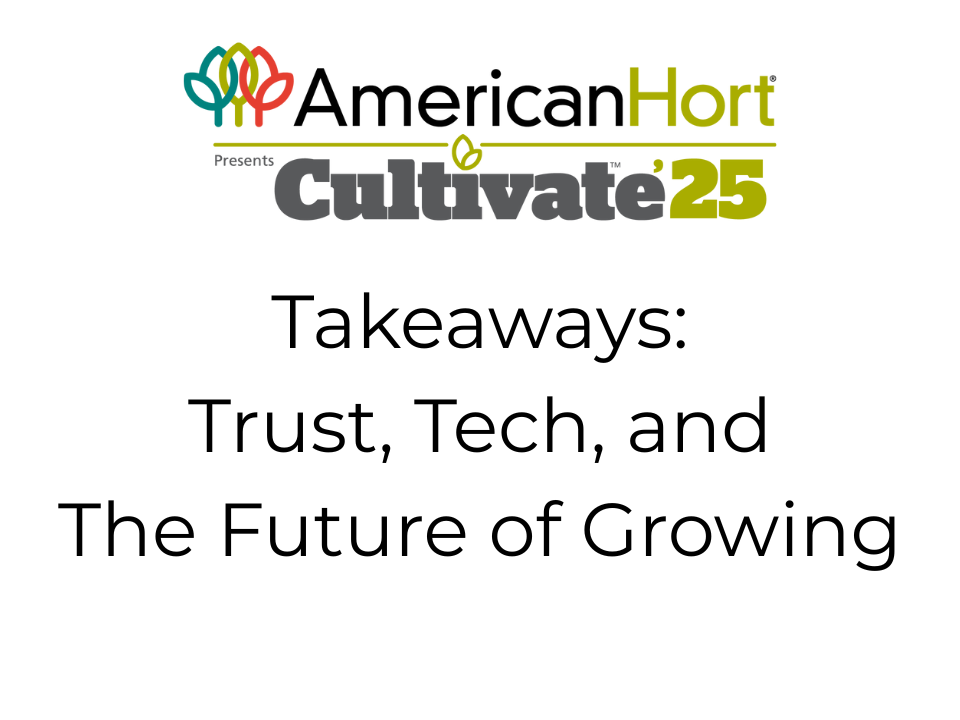
How To Calculate the Load Capacity on a Truck
August 9, 2023
Google Analytics 4 Grower Guide
August 29, 2023As we have seen in recent years, market demand in our industry can significantly move from one year to the next. For some growers, these market changes were highly beneficial. For others, they presented great challenges. Whether you were on the plus or minus side of these market swings, we have all had to incur increased costs.
In these times, a grower without a forecasting process is flying blind, without instrument backup.
Would a forecast have changed the outcome for a grower who didn’t have one?
I believe so.

What Is A Forecast?
Simply put, a forecast is a prediction of future values or quantities. Values such as sales quantities, sales revenue, profits, or costs related to your operations are all fair game for forecasting.
Note, a good forecast is not a guess at these future quantities, but a data and scenario driven calculated, statistical outcome where the best experience, knowledge, data, and customer/market information drive cogent assumptions and plans for future states.
Forecasts are driven by assumptions: data from prior years, market and business trends, and changes in pricing. Forecasts go awry when an assumption is wrong. These need to be published with the forecast.
Two Types Of Forecasts
There are two fundamental ways to go about forecasting.
Top-Down Forecast
Top-down forecasting looks at your high-level financials (typically the income statement) and pushes those values forward to future time periods. Then, you add or subtract percentages based on your assumptions about what changes impact the future state to project new values for the line items and for your bottom line. These values need a “reality check” to prior years.
For example, take your income statement line items and copy those to future years. Add or subtract values to the key line items like your sales revenue or COGS. See what happens to the bottom line.
In some cases, a grower may know concrete data to project the future. P a large customer is planning on a positive or negative overall comp for the coming year, or a crucial supplier is cutting you a better deal on your bulk raw materials for next year. This is part of what you can use the figure in the projected changes year over year to see where you land.
The advantage of a top-down forecast is that they are usually easier to put together.
However, for growers, the natural questions arise about how this high-level projection will happen (if sales are slated to go up what you will grow, how to price the items, etc.).
The disadvantage of a top-down forecast is it doesn’t tell you what to grow or when or how much directly. It may be implied depending on the grower’s product mix, but it is still just a general gauge.

Simple Income statement forecast example.
Copyright Advanced Grower Solutions
Bottom-Up Forecast
In contrast to a top-down forecast, a bottom-up forecast is built by looking at your SKU or SKU group levels, adjusting future sell quantities, prices, costs, and other economic factors and influences to arrive at estimated future totals.
A bottom-up forecast can account for specific product shortages you experienced or projects you are really long on certain inventory items. It can also account for suspected product changes, increases, or decreases in response to your local customer changes. These micro adjustments help you finer tailor your projections. They can also be scaled for any number of other factors, economic or otherwise, which may affect you in the future.
The advantage of a bottom-up forecast is the level of detail and control you can achieve and the very diagnostic views of your business.
The disadvantage is that they are complex, time consuming, and technically difficult to put together.
A bottom-up forecast is typically a ‘big data’ exercise and thus many growers simply don’t have the time or staff with the technical expertise to put one together in a timely manner and then iterate the various scenarios to come up with a really good future forecast to drive planning efforts.
However, whether you figure out how to do it yourself or hire great consultants to help you with it, the rewards for doing a forecast give you new, previously un-contemplated views of your business, and if you consider multiple scenarios in your forecast, it becomes an operational playbook for your future.
Further, a good bottom-up forecast coupled with projected costs can show you where your profits will most likely come from (or not).

A simple bottom-up forecast – what’s your number?
Copyright Advanced Grower Solutions
So, What’s A Forecast Worth?
Let’s look at a couple of simple examples from the Johnny Plant Nursery* to demonstrate the value and return of a forecast and forecast process.
Here at Johnny Plant Nursery, it has a pretty good spring. However, we did run out of some key items. Our 3Gal ‘Supra Ginormica Bloomicus’ was a big hit. We ended up selling out a couple of months before normal demand would end. Johnny Plant Nursery found and paid some awesome consultants $10,000 (just for easy math**) to do all the legwork, research, data gathering, team discussion, and analysis for a forecast to alleviate the shortfalls next year. Using our forecasting method, we see that we could have sold an extra 2,800 and that would have resulted in additional revenue of over $39,000 at our $13.99 price point.
For the one SKU alone, Johnny Plant Nursery’s return on investment will be almost 200%.
So, as you can see, in the right circumstances, it is very feasible to have a single SKU result pay for a forecasting effort. In fact, it’s a no-brainer, a slam dunk.
Let’s look at another example.
Johnny Plant Nursery is just outside the town of Redstone Valley ***. Redstone Valley is growing, attracting new residents. Initial work has begun on several projects for new neighborhoods and upscale apartment complexes and a couple of new schools. Further, several of the landscape companies in town are good customers of Johnny Plant Nursery and believe they will receive a lion’s share of these projects, which will result in more sales and larger master orders for next year. After careful consideration, Johnny Plant Nursery hires amazing consultants to help build forecast scenarios to analyze and plan for this potential growth. After the market and historical data analysis, economic factor analysis, and discussions with the team, the forecast comes in at a 22% increase for the next year and 17% for the following year. For anticipated revenue, assuming Johnny Plant Nursery is currently a $1.5-million-dollar operation the increases shown by this forecast are $330,00 in year 1 and $311,000 in year 2. With this forecast, we will grow past $2.1 million in revenue!
Consider, even if Johnny Plant Nursery only captures 80% of the potential revenue, which is still over a half million in growth over two years due to the local situation.
Without a real forecasting process and the resulting data story to show what was probable, chances are Johnny Plant Nursery would have just done a small comp on last year, basically the same thing as last year, and missed out on hundreds of thousands in new revenue. Even if Johnny Plant Nursery paid $30,000 ** for the extensive multi-year analysis and forecasting consulting process (again for easy math) the return is still exceeding 16x.
Yes, that’s right, forecasting investments can achieve impressive returns.
Bottom Line On Forecast Value
The real value in a forecast is from a foresting strategies, tactics and process (data, analysis, and market/product scenarios) coupled with a system for managing, reviewing, and tracking the associated right metrics. These will allow you to make adjustments to your operations long before you are past the point of no return.
A good forecast is not just a singular event or spreadsheet, but a working, iterative, set of data, analysis, and business processes/practices that serve to help you plan more effectively and periodically adjust as the season goes by.
With these two oversimplified examples, you can easily see the value of the results of a forecast can be 10X or even 100X the investment you make. And even though the examples were positive ones, forecasting can also help you anticipate downturn or product mix shifts and cut back on production saving you money in raw materials, labor, and carry costs. Forecasting pays for itself regardless of which direction the market is going.
AGS has experienced, expert inhouse and partner consultants, including Ken Lane of Hathaway and Lane, that and help you build and maintain your forecast and associated processes which can yield better results for your business.
Contact us today to learn more.
* Johnny Plant Nursery is a fictitious nursery, but the examples use numbers that are directionally correct.
** The actual price of a consulting engagement depends on several variables. These are just examples for demonstration purposes. Your actual cost of an engagement could be less than these examples or more depending on a wide variety of factors. In our pricing we will work with you to tailor a specific quote for your particular operational needs.
*** Redstone Valley is a fictitious town.





